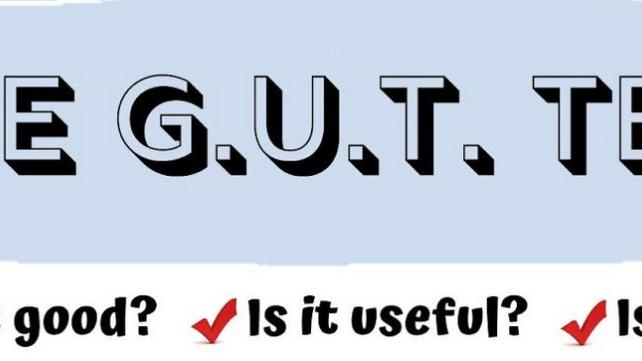
“Honesty is the best policy.”
It’s an adage we have all heard. According to many measures, it’s popular because there is truth in it. While we can all agree on the importance of honesty, as parents we need to find tried and true ways to help our children embrace it as a value, too.
Enter the G.U.T. test!
Being honest is a skill that is learned over time. The G.U.T. test1 is an effective way to help children assess how and when to tell the truth in social situations. That is because telling the absolute truth at all times can be hurtful. Sometimes it can be best to remain silent. An example will help to explain.
Mahmoud and his little sister Aisha were invited to his friend Miriam’s house for dinner. They were served Arroz con Pollo, a Puerto Rican chicken and rice dish. Neither child had eaten the dish before. Mahmoud was excited about trying something new but Aisha was leary because she spotted olives (a lot of them!) and she didn’t like olives. Miriam’s mom filled their plates and waited in anticipation as they tasted the dish. Adam loved it and was happy to say so. Aisha less enthusiastic picked through the dish to make sure she didn’t eat any olives. She liked the chicken but really didn’t care for the rice. When Miriam’s mom asked how she liked it, she wasn’t sure what to say. Should she tell the truth? What if the truth hurt Miriam’s mother’s feelings? So she pretended that she didn’t hear the question and changed the subject. She tried to only eat what she liked, but there was quite a bit left on her plate when they had all finished the meal. Aisha worried about what Miriam and her mother would think. When the two returned home later that evening, they spoke to their parents about the dilemma.
Aisha didn’t know Miriam’s mother well enough to know how she would have handled Miriam’s honest opinion. And she certainly didn’t want to be rude. Evaluating the situation using the G.U.T. test could have been helpful in the moment; it is also helpful as a means of discussing a challenging situation after the fact.
The exercise involves asking three important questions that relate to whether a person should speak the absolute truth in any situation.
Is the information GOOD to share?
Will providing the information be USEFUL?
Is the information TRUE?
Before speaking, a person can evaluate these three questions. If speaking the truth passes all three tests, then you can and should do so. But if telling the truth doesn’t pass all of these measures, then it may be better to be silent. While that might not seem like an appreciation of the truth in it’s absolute form, there is import in caring about the way that truth impacts those around us. And for Muslims, there is also precedence for taking care of the way we use our tongues.
Our best example of discerning how and when to speak the truth can be found in the life and actions of the Prophet Muhammad, peace and blessings be upon him. And while he was a huge proponent of speaking the truth,2 he also knew there were some instances where the truth could be hurtful or not well received. Abu Hurairah narrated that the Prophet said:
“Whoever believes in Allah and the Last Day let him say something good or let him remain silent.”
(Bukhari)
These are the nuances of communication that we learn more about every day. Parents can help children increase their level of understanding and consciousness about telling the truth by embracing honesty at home and discussing the implications of incorporating it into every aspect of daily life.
End Notes
1The G.U.T. Test is also attributed to the Greek philosopher Socrates and is known as his Triple Filter Test. The G.U.T. test acronym is easier for children (and most adults!) to remember.
2 Honesty: An Essential Characteristic of a Muslim
Zahirah Lynn Eppard is the managing editor of the Muslim Home parenting newsletter project. As Sound Vision’s Director of Religious Education, she has also spearheaded the production of more than 500 online classes serving children ages 3-12 in the Adam’s World and Colors of Islam Clubs. Eppard has also worked in the field of education as a teacher, homeschooler, and Islamic school principal, as a marriage and crisis intervention counselor, and as a lobbyist and social justice activist. She lives with her husband, children, and grandchildren in Maryland.



Add new comment